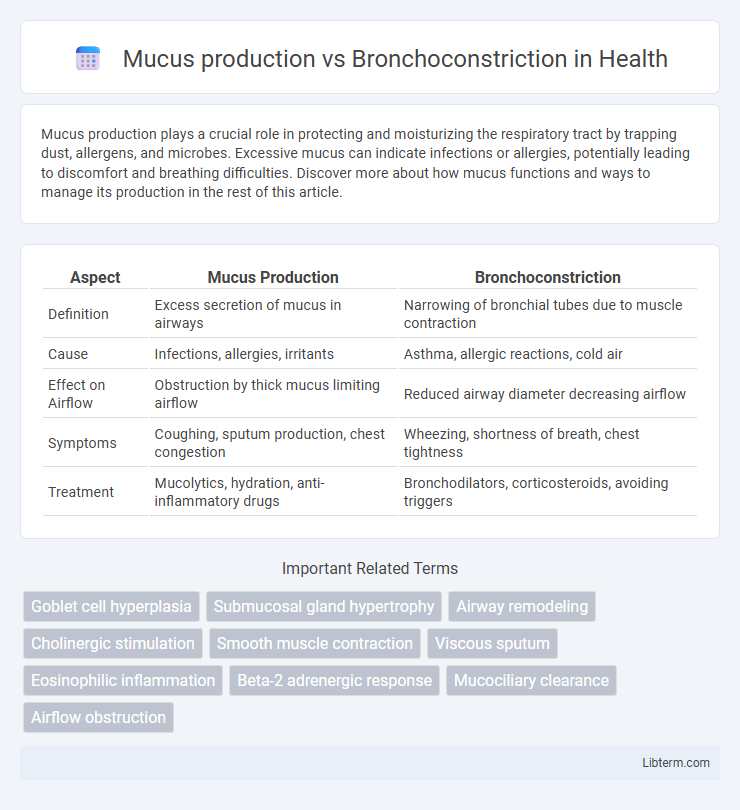Mucus production plays a crucial role in protecting and moisturizing the respiratory tract by trapping dust, allergens, and microbes. Excessive mucus can indicate infections or allergies, potentially leading to discomfort and breathing difficulties. Discover more about how mucus functions and ways to manage its production in the rest of this article.
Table of Comparison
| Aspect | Mucus Production | Bronchoconstriction |
|---|---|---|
| Definition | Excess secretion of mucus in airways | Narrowing of bronchial tubes due to muscle contraction |
| Cause | Infections, allergies, irritants | Asthma, allergic reactions, cold air |
| Effect on Airflow | Obstruction by thick mucus limiting airflow | Reduced airway diameter decreasing airflow |
| Symptoms | Coughing, sputum production, chest congestion | Wheezing, shortness of breath, chest tightness |
| Treatment | Mucolytics, hydration, anti-inflammatory drugs | Bronchodilators, corticosteroids, avoiding triggers |
Understanding Mucus Production in the Respiratory System
Mucus production in the respiratory system is a crucial defense mechanism designed to trap and eliminate inhaled particles such as dust, pathogens, and allergens. Goblet cells and submucosal glands secrete mucus, which forms a protective layer lining the airways, facilitating the removal of harmful substances via the mucociliary escalator. Excessive mucus production, often triggered by infections or chronic conditions like asthma and chronic bronchitis, can obstruct airflow and exacerbate symptoms by combining with bronchoconstriction, which narrows the airways through the contraction of smooth muscle surrounding the bronchi.
What is Bronchoconstriction?
Bronchoconstriction refers to the narrowing of the airways in the lungs caused by the tightening of surrounding smooth muscle, which restricts airflow and can lead to breathing difficulties. It often occurs in respiratory conditions such as asthma and chronic obstructive pulmonary disease (COPD), where inflammation triggers the muscles to contract excessively. Unlike mucus production, which involves the secretion of fluids to trap particles and pathogens, bronchoconstriction physically reduces airway diameter, significantly impacting respiratory function.
Mechanisms Behind Mucus Secretion
Mucus production in the respiratory tract is primarily regulated by epithelial goblet cells and submucosal glands responding to inflammatory stimuli and neural signals, which trigger the release of mucus to trap pathogens and particles. This secretion process involves cholinergic stimulation via the parasympathetic nervous system, activating muscarinic receptors that increase intracellular calcium and promote exocytosis of mucin granules. In contrast, bronchoconstriction is mediated by smooth muscle contraction regulated by parasympathetic nerves releasing acetylcholine, leading to airway narrowing but does not directly increase mucus secretion.
Causes and Triggers of Bronchoconstriction
Bronchoconstriction is primarily triggered by factors such as allergens, cold air, exercise, respiratory infections, and exposure to irritants like smoke or pollution, which cause the smooth muscles surrounding the bronchi to contract. This constriction narrows the airways, reducing airflow and leading to symptoms like wheezing, coughing, and shortness of breath, often seen in asthma and chronic obstructive pulmonary disease (COPD). In contrast, mucus production increases in response to inflammation and irritation, contributing to airway obstruction but is a separate physiological reaction from bronchoconstriction itself.
Key Differences: Mucus Production vs Bronchoconstriction
Mucus production involves the secretion of mucus by goblet cells and submucosal glands to trap and clear inhaled particles and pathogens from the respiratory tract. Bronchoconstriction refers to the narrowing of bronchial airways due to the contraction of smooth muscle surrounding the bronchi, leading to airflow limitation. Key differences include that mucus production primarily impacts airway clearance and protection, while bronchoconstriction directly affects airway diameter and respiratory resistance.
Effects on Breathing and Lung Function
Excessive mucus production clogs airways, reducing airflow and impairing gas exchange, while bronchoconstriction narrows the bronchi, increasing airway resistance and causing wheezing and shortness of breath. Both conditions decrease oxygen intake and carbon dioxide removal, leading to hypoxemia and respiratory distress. Treatments targeting mucus clearance and bronchodilation improve pulmonary function and alleviate breathing difficulties.
Common Conditions: Asthma, COPD, and Chronic Bronchitis
In asthma, bronchoconstriction primarily restricts airflow, while mucus production can exacerbate airway obstruction during attacks. COPD involves chronic inflammation that increases mucus hypersecretion and persistent bronchoconstriction, leading to airflow limitation. Chronic bronchitis, a subtype of COPD, is characterized by excessive mucus production that blocks airways and contributes to ongoing bronchoconstriction and respiratory symptoms.
Diagnostic Approaches for Airway Obstruction
Diagnostic approaches for airway obstruction differentiate mucus production from bronchoconstriction by employing spirometry, which measures airflow limitation indicative of bronchoconstriction, and sputum analysis that quantifies mucus hypersecretion. Imaging techniques like high-resolution computed tomography (HRCT) identify structural airway changes, helping distinguish mucus plugging from airway narrowing caused by smooth muscle constriction. Bronchoprovocation tests with agents such as methacholine further assess airway hyperreactivity associated with bronchoconstriction, while endoscopic examination allows direct visualization of mucus accumulation obstructing airways.
Treatment Strategies: Mucolytics vs Bronchodilators
Treatment strategies for mucus production primarily involve mucolytics, which work by thinning and loosening thick mucus in the airways to improve clearance and reduce airway obstruction. Bronchodilators target bronchoconstriction by relaxing the smooth muscle surrounding the bronchi, thus widening the airways and easing breathing. Combining mucolytics with bronchodilators is often effective in managing respiratory conditions like chronic bronchitis and asthma by addressing both mucus viscosity and airway constriction.
Preventive Measures and Lifestyle Tips
Controlling mucus production and preventing bronchoconstriction involves maintaining optimal hydration and avoiding irritants such as tobacco smoke, pollution, and allergens. Regular use of prescribed bronchodilators and mucolytics can reduce airway inflammation and ease mucus clearance, improving respiratory function. Incorporating routine exercise and breathing techniques supports lung capacity and reduces the severity of bronchoconstriction episodes in chronic respiratory conditions.
Mucus production Infographic

 libterm.com
libterm.com